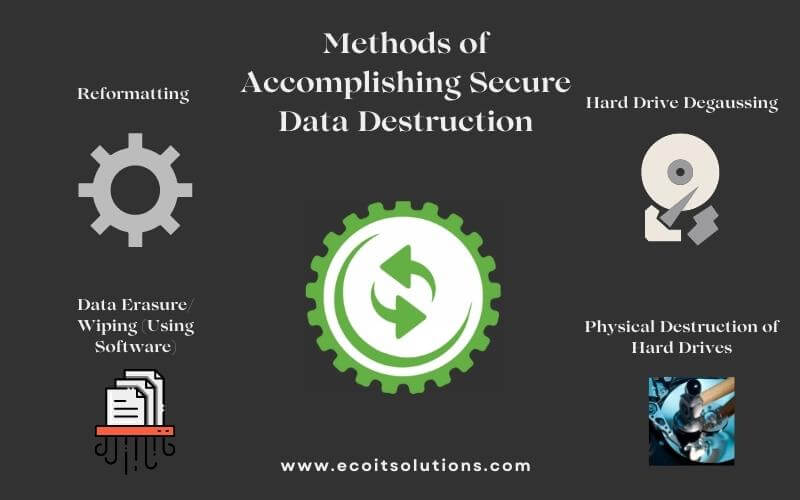Best Practices for Data Destruction to Strengthen Your Cyber Security Framework
Best Practices for Data Destruction to Strengthen Your Cyber Security Framework
Blog Article
Exploring the Importance of Data Destruction in the Context of Computer System Security Providers and Protecting Confidential Data
In an age where data violations are increasingly typical, the value of reliable information damage can not be overemphasized. When no longer necessary, Organizations has to take on stringent procedures to make sure that sensitive details is not just protected throughout its lifecycle but also decisively eliminated. The approaches used for data removal, combined with compliance to legal criteria, play a critical role in preserving confidentiality and trust. The effects of these methods prolong past plain conformity, affecting a business's reputation and functional integrity in the digital market. What strategies can organizations apply to boost their information damage methods?
Comprehending Data Devastation
Data destruction is an essential part of computer protection that includes the long-term elimination of information from storage space tools to avoid unapproved accessibility and potential information violations. In a significantly electronic landscape, companies face increased threats linked with delicate information being poorly accessed or exploited. Effective information devastation safeguards against these risks, making certain that private dataâEUR" such as consumer information, intellectual building, and economic recordsâEUR" can not be recovered after disposal.
Understanding the importance of information destruction prolongs beyond simple compliance with regulative and legal structures; it is essential for maintaining business stability and trust fund. When information is poorly taken care of or improperly ruined, the consequences can be severe, consisting of economic loss, reputational damage, and legal responsibilities.

Techniques of Information Eradication

One widespread technique is data wiping, which entails overwriting existing information with random patterns several times. This strategy renders the original information irretrievable, making it a popular option for organizations looking for to shield confidential info.
An additional approach is degaussing, which utilizes an effective magnetic area to interrupt the magnetic domain names on storage devices, effectively getting rid of the data. This strategy is especially efficient for magnetic media however is not appropriate to solid-state drives.
Physical damage is one more robust approach, including the shredding or crushing of storage space gadgets. This technique warranties that information recuperation is basically difficult, making it optimal for highly delicate details.
Lastly, file encryption can act as a complementary method to data eradication. By securing data before deletion, organizations can add an extra layer of safety and security, making sure that even if remnants are recouped, they continue to be unattainable without the decryption trick. Each approach must be picked based upon the degree of information level of sensitivity and the certain safety and security requirements of the company.
Legal Compliance and Data Protection
Organizations need to navigate a complex landscape of lawful requirements connected to information safety, particularly after executing techniques of information removal. Different regulations, such as the General Information Defense Guideline (GDPR) and the Wellness Insurance Policy Portability and Liability Act (HIPAA), enforce rigorous standards on just how organizations should take care of and dispose of delicate data. Failing to adhere to these policies can cause considerable legal consequences, including considerable fines and reputational damage.
Data destruction processes need to be carefully recorded to demonstrate compliance with appropriate laws and criteria. This documentation not only functions as proof of adherence hop over to here to lawful commitments however likewise illustrates a commitment to safeguarding sensitive information. Organizations must additionally establish clear plans regarding data retention and destruction timelines, making certain that data is not held longer than necessary.

Moreover, routine audits and assessments of information devastation techniques are vital to keep conformity and adjust to evolving legal structures (data destruction). By proactively attending to legal requirements, organizations can mitigate threats linked with information violations and show their commitment to information protection. Ultimately, prioritizing legal compliance in data damage processes is not just a regulatory obligation, however a basic element of a robust information safety and security strategy
Impact on Organization Credibility
The track record of a service can be significantly affected by its approach to data devastation and monitoring. In today's electronic landscape, where information violations can happen at any type of moment, the failure to correctly take care of delicate information can bring about serious effects. Organizations that improperly handle information devastation threat subjecting private client details, which not just violates privacy regulations but additionally wears down depend on among stakeholders and customers.
A damaged online reputation can cause lowered customer commitment, as customers come to be reluctant to involve with a company that has important site shown carelessness in shielding their information. In addition, adverse publicity bordering an information violation can have an enduring result, as prospective clients might be deterred by the regarded absence of safety. This can bring about a straight decline in earnings and market share.
Furthermore, businesses that prioritize data destruction as component of their safety and security strategy can boost their reputation by showcasing their commitment to protecting delicate info. By taking on rigid information management methods, organizations can not just alleviate dangers yet likewise place themselves as trustworthy entities in their corresponding industries, therefore reinforcing their total brand image.

Best Practices for Secure Disposal
Carrying out best practices for safe and secure disposal of information is necessary for mitigating threats connected with information violations and making sure conformity with privacy laws. Organizations ought to take on an extensive data disposal policy that lays out treatments for both physical and electronic information devastation.
For physical information storage space devices, such as hard disk drives, shredding or degaussing is advised to avoid data healing. Furthermore, organizations should maintain a chain of custody paperwork throughout the disposal procedure, making sure liability and traceability of disposed things.
For digital information, utilizing software program that sticks to sector requirements for information cleaning is crucial. This software program ought to overwrite existing data numerous times, making recovery basically difficult. It is also essential to validate the effectiveness of the information devastation procedure through audits or third-party analyses.
Training workers on safe and secure disposal practices includes one more layer of safety and security, as human error can typically cause data exposure. Routinely evaluating and upgrading disposal policies makes certain positioning Get More Info with developing guidelines and technical advancements. By carrying out these ideal practices, companies can substantially minimize the risk of unapproved information gain access to and improve their general data security method.
Final Thought
Finally, information destruction is a basic element of computer protection solutions that guarantees the protection of private info from unapproved gain access to. Carrying out efficient methods of data obliteration, adhering to legal compliance, and acknowledging the influence on service track record are important elements of a detailed information safety approach. By adopting ideal practices for safe and secure disposal, organizations can cultivate trust with clients and protect sensitive data, inevitably contributing to an extra safe and secure digital landscape.
In a period where information violations are progressively usual, the importance of reliable data destruction can not be overemphasized.Data devastation is a vital part of computer security that entails the irreversible removal of data from storage space tools to avoid unauthorized access and prospective data violations. Organizations should additionally establish clear policies pertaining to information retention and damage timelines, making certain that information is not held longer than necessary.
By proactively resolving lawful requirements, companies can reduce threats associated with data breaches and show their dedication to data protection (data destruction). Eventually, focusing on legal compliance in information devastation processes is not simply a regulatory obligation, yet an essential element of a durable data safety approach
Report this page